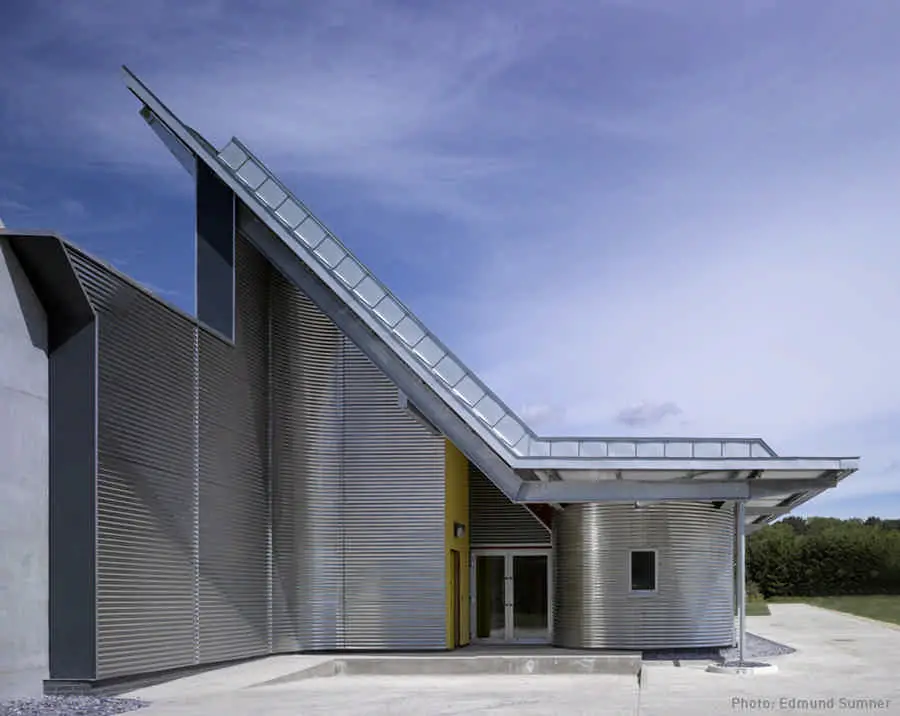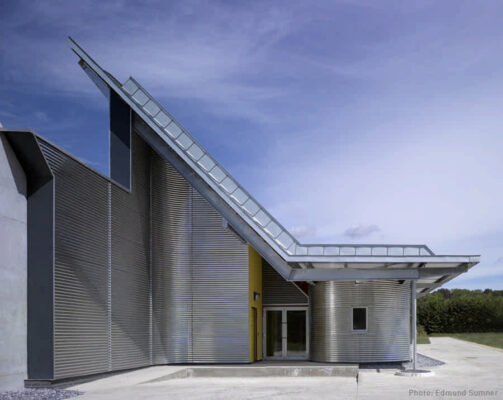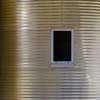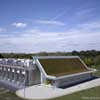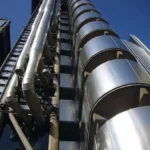BFI Acetate & Nitrate Film Stores, Warwickshire Architecture, Architects, English Project News
BFI Master Film Store Building
BFI Acetate & Nitrate Film Stores Building, Warwickshire design by Edward Cullinan Architects, UK
28 Jun 2012
Design: Edward Cullinan Architects
RIBA Awards 2012 Citation:
BFI Master Film Store
BFI Acetate & Nitrate Film Stores
This building might be described as a Modernist machine for preserving culture. The film stores protect 190,000 canisters of unstable nitrate film, and 240,000 acetate reels at minus 5C, and at a fixed humidity. The archive could have been a simple response to functional imperatives – a serviceable oblong of concrete bunkers equating form with function – but this is more ambitious: a matrix of concrete bunkers clad with corrugated stainless steel; a distinct, characterful piece of architecture.
In plan, elevations and material detailing, the Archive’s design draws from both a stripped down industrial modernism, yet also radiates a very particular kind of 21st century finesse and environmental efficiency.
The Archive, said to be technically superior to its US counterpart, is exemplary in both architectural and cultural terms.
RIBA Awards winner, 2012
BFI Acetate & Nitrate Film Stores – Building Information
Location: Confidential location
Architect: Edward Cullinan Architects
Client: British Film Institute
Contractor: Gilbert Ash (NI) Ltd
Structural Engineer: Curtins Consulting
Services Engineer: Couch Perry & Wilkes
Contract Value: £9 million
Date of completion: Sep 2011
Gross internal area: 2,900 sqm
Chair of Jury: Pierre Wassenaar
Regional representative: Kevin Singh
Lay assessor: Jay Merrick
BFI Acetate & Nitrate Film Store images / information from RIBA
1 Sep 2011
BFI Acetate & Nitrate Film Stores Building
Design: Edward Cullinan Architects
BFI Master Film Store
Project Description
This pioneering new Master Film Store will preserve the British Film Institute’s (BFI) master film collections of nitrate and acetate film. When complete, the building will be the first of its kind to store large quantities of film, over 450,000 canisters, in optimal environmental conditions.
The building is the result of intense research and collaboration between the architect, engineers, film experts and the BFI to define the best solution for storing this large collection of film, sustainably, for the next 50 years and beyond. The vaults will keep the film in cold and dry conditions of -5ºC at 35% relative humidity, while the fabric and services enable this environment to be maintained in an energy efficient way.
Although the building form is quite simple, consisting of 30 identical cellular vaults for nitrate film and 6 vaults for acetate film, the specification required an extremely low air leakage rate of 0.3m3/hr at 50 Pascals to maximise performance.
Rigorous analysis, detailing and quality control has been carried out to ensure the building will provide the sub-zero temperature, low humidity and fire prevention that the film requires for its preservation.
The building will achieve a BREEAM ‘Excellent’ rating.
Introduction
This autumn, the British Film Institute (BFI) will reach a major milestone in their long history of preserving the nation’s film heritage. A pioneering new building will be complete and ready to house the BFI’s entire master collection of acetate and nitrate film in closely controlled environmental conditions ideal for the long-term protection of this priceless and vulnerable material.
The Project has been realised through the Screen Heritage UK (SHUK) programme, a nationwide initiative funded by the Department of Culture, Media and Sport. One of its key objectives is to prevent the deterioration and loss of the nation’s films so that they can be made accessible now and in the future. The BFI cares for the most significant film collection in the world. It represents the history of the moving image in Britain from pre-cinema through to the present day. The collection is currently stored over two sites; the new building will consolidate the collection into their existing site in Warwickshire.
The building is designed by Edward Cullinan Architects who led a detailed feasibility study which concluded that the BFI’s existing archive buildings could not be suitably upgraded, and that a new ‘sub-zero’ storage facility large enough to house all master acetate and nitrate material should be constructed at the earliest opportunity.
The final technical solution is the result of intense research and collaboration between the architect, engineers, film experts and the BFI to define the best method for storing such a large collection of film sustainably for the next 50 years and beyond.
At just under 3000m², the new vaults will store up to 460,000 canisters of film in conditions of -5°C at 35% relative humidity, while the construction enables the building to sustain these conditions in an energy efficient way.
Pre-cast concrete panels provide the thermal mass required to limit temperature fluctuations. Although the building form is quite simple, consisting of 30 identical cellular vaults for nitrate and 6 vaults for acetate film, the specification requires extremely low air leakage rate and must withstand intense heat in the unlikely event of a nitrate film fire. Rigorous analysis, detailing, quality control and testing has been carried out to ensure the building will provide the sub–zero temperature, low humidity and fire prevention that the film requires for its preservation.
When complete, the building will be the first of its kind to store large quantities of film in such cold and dry conditions; it will also achieve a BREEAM Rating of ‘Excellent’ for its sustainable features.
BFI Acetate & Nitrate Film Stores Warwickshire – Building Information
Design Team Appointed: Jul 2009
Construction period commenced: Oct 2010
Construction Cost: £9 million
Cost per m2: £3,000
Planning approved: Jun 2010
Target Completion Date: Dec 2011
British Film Institute (BFI) Master Film Store – Team
Client: BFI Sarah-Jane Lucas (BFI Strategic Projects); Peter Watson
Architect: Edward Cullinan Architects
Carol Costello (Project Director)
David Leggett (Project Architect)
Ted Cullinan, Tim Francis, Brendan Sexton, Lucy Spencer
Structural Engineer: Curtins Consulting
Services Engineer: Couch Perry & Wilkes
Project Manager: Buro Four
Quantity surveyor: W H Stephens
CDM Coordinator: Arcadis
Main contractor: Gilbert Ash NI
BFI Acetate & Nitrate Film Stores images / information from Edward Cullinan Architects
AIA UK Excellence in Design Awards : Commendation. 20 Apr 2012
Location: Warwickshire, England, UK
Warwickshire Buildings
New Warwickshire Buildings – Selection
Royal Shakespeare Theatre – redevelopment, Stratford-upon-Avon
Bennetts Associates

image © Peter Cook
Royal Shakespeare Theatre
Warwick Students Union
MJP

photograph © Peter Durant
Warwick Students Union
Bluebell Views Student Residences, University of Warwick
Page Park Architects

picture from architects
University of Warwick Student Residences
The Royal Shakespeare Company Courtyard Theatre, Stratford-upon-Avon
Ian Ritchie Architects Ltd
Warwickshire building
British Horse Society Headquarters Building, near Coventry
Archial
British Horse Society Warwickshire
Buildings / photos for BFI Acetate & Nitrate Film Stores page welcome

